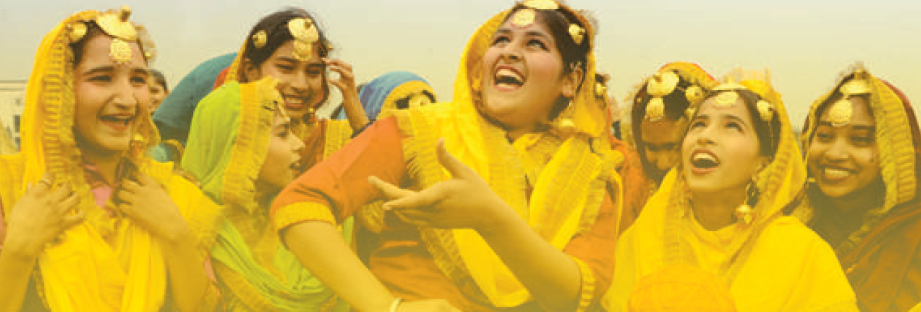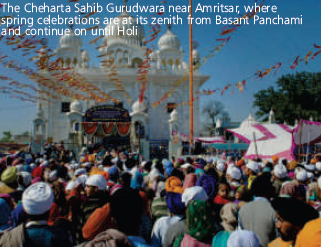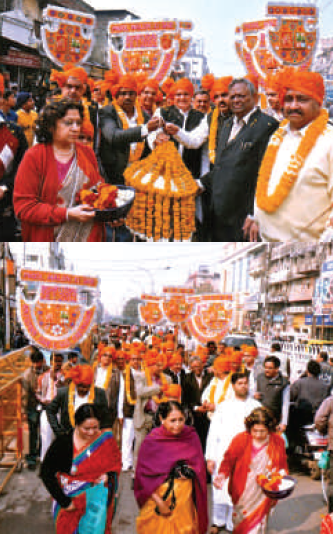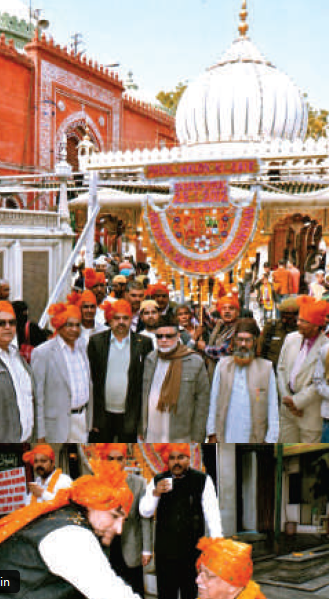Basant (spring)
This is a collection of articles archived for the excellence of their content. Readers will be able to edit existing articles and post new articles directly |
Contents |
Basant
By Gen O Dwyer
Carnival Time
India Harmony Volume - 1 : Issue - 2, 2013
In North India
Basant, the onset of spring is carnival time in India, and especially in Punjab. When nature carpet-bombs the earth in a sea of yellow – mustard flowers bobbing their heads and golden wheat ears swaying in the breeze, the Punjabi zeitgeist is in full cry.
The verdure in the ground beneath is matched with a zillion-hued kites darting and leaping across the sky. And from Basant Panchami in Januray-end to Holi in March it is a time of joy and vim.
In the season of renewal of life, as Nature slowly unfolds her immense bounty, obeisance is paid to the Lord of creation.
And the season of re-birth and bloom is also the season of amour. Kaamadeva and his companion Vasanta are worshipped. Kalidasa in his Ritu samhara and romantic Abigyana Shakuntalam has waxed eloquent on spring. The first encounter of enchantment between Shakuntala and King Dushyanta are in Vasant ritu, the season of spring.
peeli peeli sarson phooli peeli udey patang arre peeli peeli uddi chunariya peeli pagdi ke sang galey lagaa ke dushman ko bhi yaar banaa lo kahey malang aayee jhhom ke basant jhoomo sang sang mein aayee jhhom ke basant jhoomo sang sang mein aaj rang lo dilon ko rang lo rang lo dilon ko ik rang mein aayee jhhoom ke basant jhoomo sang sang mein aayee jhhoom ke
Braj Mandal, the land of Lord Krishna which covers Agra, Mathura, Vrindavan and Goverdhan turns yellow with flower decorations, banners, rangoli and people sporting yellow kurtas on Basant Panchami, heralding the advent of spring. The lore of Radha and Krishna's romance and the Holi celebrations are legendary.
The famous Urdu poet Faiz Ahmed Faiz has penned the nazm titled
Bahaar Aayee (Spring is here) “Bahaar aayee toh jaisey yak baar laut aaye hain phir adum se woh khwaab saarey, shabaab saare, jo terey honton pe mar mittey thhe, jo mit kar ke har baar phir jeeye thhe/nikhar gaye hain gulaab saare/Bahaar aayi toh khul gaye hain/naye sirrey se hisaab saarey/bahaar aayee, bahaar aayee .”
(With the coming of spring, once again have returned all those thoughts, all that youthfulness….roses have bloomed again which are fragrant with memories of you).
However, the Punjabi spirit is more in keeping with the inimitable genius Mirza Ghalib's verse:
"The Spring came with such abandon That the sun and the moon became mere spectator"
Men and women dressed in yellow and golden finery break out in dance and song to the beat and verve of Bhangra and Giddha, the special dance forms of Punjab. The Bhangra is a dance which involves a a lot of jumping to the accompaniment of drums. Gidda is a lively dance where the womenfolk perform to the tune of folk verses. These verses are called bolis and dwell on several social aspects from arguments with in-laws to recurring political issues. Sweetmeats are a fine blend of kesar and yellow halwas.
Soaking in the gentle spring, children swing in gay abandon and Revellers are busy trying to outwit one another in the skies trying to cut the strings of each other's kites. The moment a kite is snapped from an opponent's string, there are triumphant whoops.
In Amritsar
Chheharta Sahib Gurudwara near Amritsar comes alive with devotees thronging the shrine. Though this fascinating season has its distinct music in the chirping of the birds and buzzing of the bees among the lush green fields and gardens, the music which it gives rise to in the human heart found its way in the form of “Raga Basant” long ago. Guru Nanak, Guru Amar Das, Guru Ram Das and Guru Arjan Dev composed shabads in this raga, which are in Guru Granth Sahib. Performed in slow tempo, this gentle melody depicts quiet joy. According to tradition, it is sung in the Sikh Gurdwaras from the festival of Maghi (after Lohri) till Hola Mohalla. It is indeed a divine experience to hear these shabads. The most popular shabad in the raga is Dekh Phool Phool Phooley and has been rendered by almost every 'Ragi' with individual variations.
The Muslim Sufis adopted this festival in the thirteenth century as a way of participating in the community activities of the area they had settled in. By the Mughal period, Basant was a popular festival at the major Sufi shrines. Spring festivals were reportedly arranged around the shrines of various Muslim saints. Lahore, which housed several Sufi shrines, also acquired these traditions and turned these into popular local traditions. Amir Khasru, the famous Sufi-poet of the thirteenth century, even composed verses on Basant. From Basant to Holi is a time of enjoying the slow turn of spring's first shoots into a riot of colours. Holi – the festival of colours is celebrated on the day after the full moon in early March and glorifies good harvest and fertility of the land.
In Lahore
Across the border
The spring festival celebration in Lahore (which has been banned for the last two years) usually opens up with a colourful ceremony featuring performance of 16 army bands, folk dances of Punjab, displays of brass band, fireworks, acrobatics and stall of traditional foods and Across the border in Pakistan, Basant is celebrated with gusto at the end of February or in the beginning of the month of March (depending on weather) has traditionally been a wildly colorful festival that covers the skies of Lahore with swooping triangles and the streets of Lahore with gangs of bow-kata kids. Known as Jashn-e-baharan, Basant festival artisans at work. The festivities simultaneously run at Jilani park, Minar I Pakistan and Gulshan I Iqbal for the public who gather in large numbers. Cultural troupes from other provinces, besides Punjab, along with foreign music groups perform at Jilani park. Free music programmes are presented at Tourist street, Old Anarkali, Jilani Park, Mini Tollinton Market and National Bank Park on Basant night. A Basant Rang music programme is presented at Noor Jehan Hall of the Alhamra Cultural Complex Qadahafi Stadium.
Colourful gates are built at all entries including airport, railway station, Ravi bridge, Minar I Pakistan, Thokar Niaz Beg, Chungi Ammar Sadhu and Motorway toll plaza to greet the people reaching Lahore. Gowalmandi food street, Old Anarkali tourist street and Gulberg main boulevard wear a festive air.
There is no place other than Lahore where Basant is celebrated with a lot of passion and enthusiasm. In fact, the city used to host the world's biggest kite flying festival and therefore Basant fever spread to other neighboring cities too.
In Lahore, it has always been about paychay (kite flying competition) from dawn until dusk. The competition involves having the strings (with glass powder pasted) of two flying kites to cross each other in the sky. The winner's party is the one who will cut the string of another party and then there will be shouts of “Bo Kata, Bo Kata”. The winner is so excited that he will often not realize that his hands are bleeding as a result of cuts from the string. Several boys can be seen on the roads keeping track of the kites that drift down when their strings are cut and chasing the catches. The sky looks like surface of a lake scattered with the petals of flowers, breath-taking scenery on the large canvass of the sky. A peaceful and soothing balm to the soul.
With the passage of time, the excitement of kite-flying has intensified innovatively paving the way for night Basant. Competitors have high capacity spot lights installed on their roofs with dozens and dozens of white kites in their stocks that illuminate in the lights. White paper kites shimmer in the night sky, diving and soaring as rival fliers joust in duels marked by battle cries of Pecha! and victory shouts of bo kata! Bursts of drums and trumpets mark the cutting of a kite's chord.
Even as the orgy of kite-flying is on, there are rooftop soirees, garden parties and equestrian events. Lahorites and out-of-town enthusiasts don glamorous clothes, in the yellow and green of spring flowers blooming citywide, to bid farewell to the frosts and fogs of winter and usher in spring.
Flood lights search the skies for that little piece of paper with reflecting patches. Fingers bleed, get taped, bleed. Proud patches of a day well-spent for the next week. The knee-high stash of gudis dwindles away. The string flies away from the fingers......
In Purani Dilli
India Harmony Volume - 2 : Issue - 1, 2013
The Anjuman-Sair-e-Gul Faroshan is a unique society established in 1961 under the patronage of Pandit Jawahar Lal Nehru. The moving spirits behind this venture were Shri Yogeshwar Dayalji a well known businessman and Janab Nooruddin Ahmed Saheb, a celebrated stalwart of the Delhi Bar and a highly regarded criminal lawyer. These were the leading lights of the Chandni Chowk area in pre-partition Delhi. Both were dedicated Indian nationalists and determined to preserve the cultural traditions of then city.
Their passionate advocacy of preserving the atmosphere of peaceful coexistence and celebration of diverse festivals in 'Purani Dilli' led them to revive the “Phool Walon Ki Sair" festival founded by the Mughal Emperor, Akbar Shah II, and his consort, Begum Mumtaz Mahal, in 1808. The first procession took place when the Begum went to the Dargah of Khwaja Bakhtiyar Kaki at Mehrauli to offer a “Chadar” of flowers. She had prayed fervently at this shrine for the release of her son who had been captured and exiled by the British. On his release, a celebration was organized commencing with the Begum proceeding to the Dargah to redeem her pledge and to offer thanksgiving. On orders of the Emperor, the procession was directed to offer a floral 'Chhatri' also at the adjacent Yogmaya Temple. The entire city joined in the celebrations with great enthusiasm. Seeing the participation of the common people of all faiths and hues, the Emperor decreed that the festival would be held every year after the rains. The next forty years saw the celebrations grow from strength to strength reaching their zenith under the rule of Bahadur Shah Zafar when the festivities spread over one week. Alas the Mutiny in 1857 and the ruthlessness with which it was quelled put an end to all celebrations. The devastation of the old city and its culture took its toll. The subsequent repression by the British put an end to this celebration too. However, the spirit of harmony survived and the people of Dilli with the help of some wealthy patrons continued to take out a small procession to the Dargah and Mandir at Mehrauli under the watchful but sympathetic eye of the then British Deputy Commissioner. In 1942, the British finally banned this festival in preparation for the final severance of the harmonious ties between the two communities. Partition and the bloodbath that followed cast a pall of gloom over the old city.
Undeterred by events, Shri Yogeshwar Dayalji took the lead in reviving the “mela” with his own funds. His dedication to Indian arts and traditions had resulted in his Havali being thrown open to artists, singers and musicians of all faiths. During the week long “Phool Walon Ki Sair” mela in the nineteen sixties his home was the centre of all activity and the atmosphere became that of a wedding celebration. Food and hospitality was open to all. He presided over this festival with great devotion for 45 years until his death in 2006. Hs last wish was for the “Sair” to continue in the manner and tradition followed by him. His vision and spark continues to live in the hearts of Delhi's citizens who celebrate the week long festivities every year under the dynamic leadership of Smt. Usha Kumar, a well known High Court lawyer and daughter of Shri Yogeshwar Dayalji. A daughter's homage to her father and her own commitment to this festival has brought cheer to the citizens of Chandni Chowk and Mehrauli who enjoy the seven day mela Her work has earned her accolades and patronage from Smt. Sheila Dixit, Hon'ble Chief Minister of Delhi, Shri Salman Khurshid, Hon'ble Union Minister of Law and Shri Tejendra Khanna, Hon'ble Lt. Governor of Delhi. The entire Mehrauli area comes alive with kite flying, wrestling and qawwali competitions at the “Jahaz Mahal”. The music and celebrations bring together the old spirit of “Bhaichara” and the “Ganga -Jamni Tehzeeb” which has survived against all odds.
In 2011, Smt. Usha Kumar celebrated the golden jubilee of the Anjuman Sair e Gul Faroshan by organizing a citizen's harmony walk on the occasion of Basant Panchmi – a celebration of the advent of spring. The walk began with a prayer at Gauri Shankar temple at Chandni Chowk and ended at the Dargah of Hazrat Nizammuddin. Eminent citizens of both communities participated, carrying yellow marigold pankhas and wearing multicolored turbans. The spirit of bonhomie continued as they followed the “Shehnaiwalas” and the entire congregation into the Dargah where they placed a “Chadar” on the mazaar and were welcomed by the 'Gaddinasheen' at the Dargah. The India Harmony Foundation participated in this walk on Basant Panchmi, 2012. It salutes the indomitable spirit and courage of Smt. Usha Kumar and offer her its wholehearted support in her mission.






